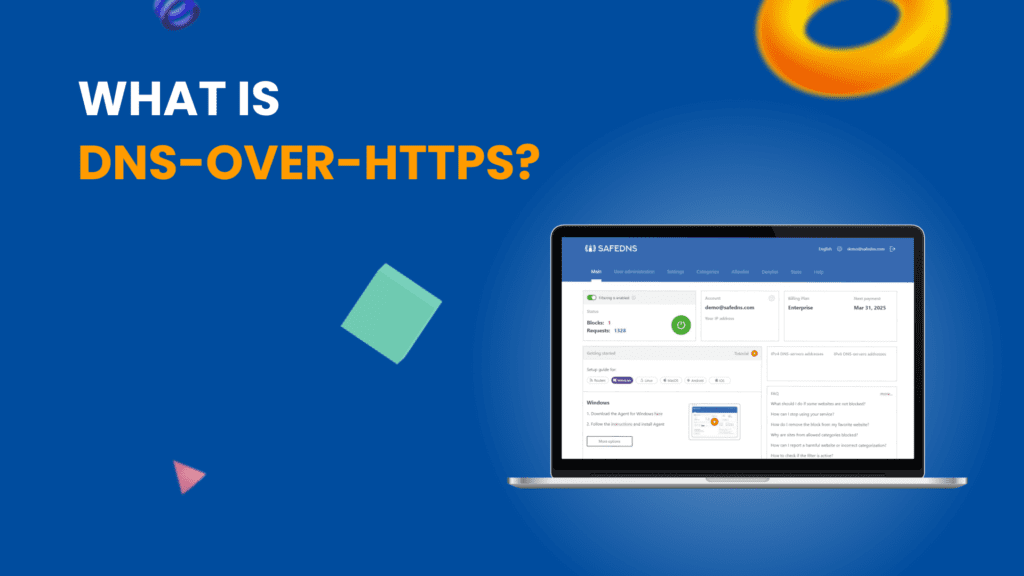In the ever-evolving landscape of internet security, Encrypted DNS-over-HTTPS (DoH) has emerged as a powerful tool designed to enhance online privacy by encrypting DNS queries. While this protocol significantly improves user confidentiality by protecting DNS requests from eavesdropping, it also introduces new surveillance risks, particularly for enterprises and security professionals. This article delves into the surveillance risks associated with DoH, its implications for cybersecurity, and strategies to mitigate these challenges.
What is DNS-over-HTTPS (DoH)?
DNS-over-HTTPS (DoH) is a security protocol that encrypts DNS queries using HTTPS, the same protocol that secures websites. Traditionally, DNS queries are transmitted in plaintext, making them vulnerable to interception by ISPs, governments, or malicious actors. DoH prevents such eavesdropping, ensuring that DNS requests are secure and private.
However, the very feature that enhances privacy—encryption—also makes it challenging for network administrators to monitor DNS traffic effectively, which can inadvertently aid malicious activities.
Surveillance Risks of Encrypted DoH
1. Hindrance to Network Monitoring and Threat Detection
One of the primary risks of DoH is that it blinds traditional network monitoring tools to DNS traffic. Security solutions like intrusion detection systems (IDS) and security information and event management (SIEM) tools rely heavily on DNS visibility to detect threats. Encrypted DNS queries obscure this critical data, potentially allowing malicious activities to go undetected.
2. Increased Potential for Malware Exploitation
Cybercriminals can exploit DoH to conceal command-and-control (C2) communications. Malware using DoH can bypass traditional security filters, as encrypted DNS traffic blends seamlessly with regular HTTPS traffic. This makes it harder to identify and block malicious domains, increasing the risk of data breaches and cyberattacks.
3. Centralization Risks
While DoH enhances individual privacy, it often relies on a few centralized DNS providers like Google or Cloudflare. This centralization creates potential surveillance risks, as these providers become lucrative targets for cyber espionage. A breach or misuse of data by these entities could expose sensitive browsing information at scale.
4. Bypassing Enterprise Security Policies
DoH can be configured at the device level, allowing users to bypass corporate DNS filtering policies. This undermines an organization’s ability to enforce security protocols, monitor web usage, and prevent access to malicious or non-compliant content.
5. Complex Incident Response and Forensics
In the event of a security breach, forensic investigators rely on DNS logs to trace the attack vector. With DoH encrypting these logs, incident response teams face significant challenges in reconstructing attack timelines and identifying compromised systems.
Balancing Privacy and Security: Mitigation Strategies
While the risks associated with DoH are significant, organizations can adopt strategies to manage them effectively without compromising user privacy.
1. Deploy Internal DoH Resolvers
Organizations can implement their own DoH resolvers within their network. This approach retains the privacy benefits of DoH while allowing security teams to monitor DNS queries for threat detection.
2. Use Secure Web Gateways (SWG) and Next-Gen Firewalls
Advanced security solutions like SWGs and next-generation firewalls can inspect encrypted traffic, including DoH. These tools use SSL/TLS decryption techniques to analyze traffic without compromising data security.
3. Implement DNS Policy Controls
Enforcing DNS policies at the network level can help manage DoH traffic. Organizations can block or redirect unauthorized DoH traffic to approved resolvers, ensuring visibility and control over DNS queries.
4. Enhance Endpoint Security
Endpoint Detection and Response (EDR) tools can provide visibility into DoH usage at the device level. By monitoring endpoint behavior, organizations can detect anomalies associated with malware or unauthorized DoH configurations.
5. User Awareness and Training
Educating employees about the risks and proper use of DoH is crucial. Training programs should emphasize the importance of adhering to corporate security policies, even when using privacy-enhancing technologies.
Conclusion
Encrypted DNS-over-HTTPS (DoH) is a double-edged sword. While it offers enhanced privacy for individuals, it also presents surveillance risks that can compromise enterprise security. By understanding these risks and implementing robust mitigation strategies, organizations can strike a balance between privacy and security in today’s complex digital environment.
Maintaining visibility into network activities while respecting user privacy is the key to leveraging DoH effectively without exposing systems to new vulnerabilities.


